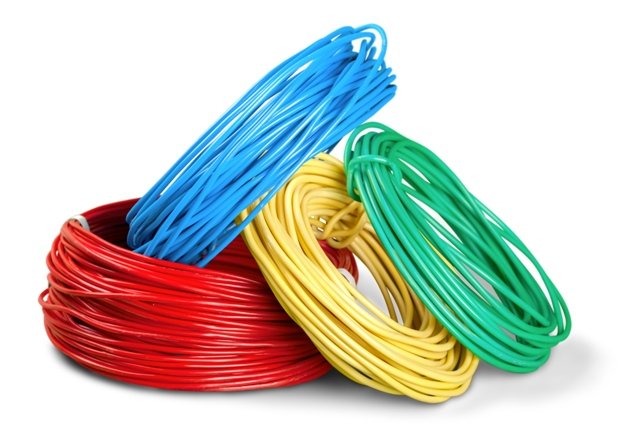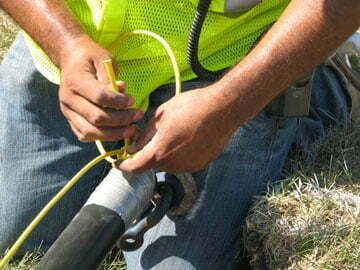There are many different types of tracer wire that are often used in the current market. For example, copper-clad steel and copper-core polyethylene insulated cables, etc., these tracer wires in the actual application process, have their own benefits, but which tracer wire can meet the underground laying of gas pipeline tracer wire selection. Should also be based on the specific PE pipeline erection needs to adjust.
In this paper, during the actual research process. For PE pipeline tracer wire selection and laying of targeted analysis. The current situation is summarised in the selection of tracer types in the process of laying PE pipelines.
At the same time, in this paper. A special comparative test analysis is carried out for three commonly used tracer wires in the hope of providing a reference note for the selection of tracer wires for PE pipelines.
PE pipe tracer test principle
PE pipes are used as specialised gas transmission pipes. It is important to analyse the principles of tracer testing. In this way, it is possible to find the appropriate technology for the application of tracer testing of PE pipes at the same time.
First of all, in the testing of tracer wires, the choice of material should be clear. The choice of material for testing should be clear, in general the material of the tracer wire tested has copper core wire and copper clad steel 2 kinds, in the actual application process, in order to make the nature of the application of the tracer wire in the pipeline test and the application efficiency clear, should be in the actual testing process, the choice of targeted testing methods, before the performance of the pipeline test up in a comprehensive manner.
In this paper, in a practical study. In this paper, the test method chosen for the pipeline is the PCM electro-decay method, by which the insulation of the pipeline tracer wire is specifically recorded. The test is carried out in accordance with the performance record.
When the test process, a frequency band within the electric wave signal fluctuations, it is possible to follow the fluctuations of its signal to determine the material of the special tracer line, which is an important prerequisite to ensure the application of PE pipeline tracer line technology.
Selection and laying of tracer lines for PE pipes
In order to ensure that the selection of tracer lines for PE pipelines meets the basic PE pipeline erection requirements, attention should be paid to the selection of tracer lines in the actual pipeline design process.
Only after the tracer has been selected can the pipeline be laid in accordance with the specific pipeline erection requirements. In the process of laying the pipes, the electrical conductivity and corrosion resistance of the pipes should be guaranteed and the application of the tracer wires should also be guaranteed to meet the basic practicalities.
In the selection process of the tracer wire, copper wires with a cross-section of more than 2.5 mm² should be selected, while in the selection of the copper wire, attention should be paid to the management of the insulation of the copper wire, and the signal transmission capacity of the copper wire should also be kept intact, so that the selection of the tracer wire for PE pipes can be fully satisfied. In the process of laying the tracer wire, the ground leakage point of the tracer wire should be managed in accordance with the special pipeline erection requirements, so that the application of the pipeline tracer wire can be comprehensively and effectively enhanced in the management.
The ground connection of the tracer line should be prevented from being covered by mud and other debris during leap time.
Comparative analysis of PE pipe tracer test results
1.Overview of pipeline testing
The so-called PE pipe tracer test refers to the actual test process of copper-clad steel, copper-clad aluminium and copper-core wire burst into the special treatment and then set up on top of the pipe, the length of the entire PE pipe set up for 600m, the three different materials of the wire conductivity test, and in the test process, to focus on the performance of each wire and wire corrosion resistance of the special test, so that the test results of the three different materials can be compared.
This will enable the test results of the 3 different materials of wire to be compared during the test. Finally, a suitable tracer wire is selected for the special PE pipe installation.
2.Selection of the type of pipeline test tracer
There are roughly three types of pipeline tracer, each of which has its own special application effect.
In practice, special tracer types should be selected according to their performance. Specific tracer types, types and their performance are shown in the table.
| Type | Cross-section/mm² | Length/m | Deep underground burial range/m |
| Copper clad steel wire | 1.0~2.5 | 600 | 0.95~4.5 |
| Copper clad aluminum wire | 2.0 | 600 | 0.95~4.5 |
| Copper wire | 1.0~2.0 | 600 | 0.95~4.5 |
3.Analysis of pipeline test items
The analysis of the PE pipeline tracer line test items are divided into three categories according to their specialised test application effects and performance as follows.
- detection of the strength of the signal transmission using the PCM pipe attenuation method
(2) Testing the anti-corrosion treatment of the joints between the tracer lines and, according to the results of the test, analysing whether the tracer lines can be used in the long term
- installation of the tracer in a fixed area to test its ability to locate the spatial position of the pipe in time.
4.Data logging for pipeline testing
In the actual test process, in order to ensure that the test data results are comparable, therefore, data signal acquisition was carried out at 8 points, and the collated data acquisition is shown in the table.
| Point serial number | Distance/m | Deep underground/m | Current signals Copper clad steel wire | Current signals Copper clad aluminum wire | Current signals Copper wire |
| NO.1 | 125 | 1.25 | 98.2 | 96.3 | 99.2 |
| NO.2 | 220 | 1.21 | 93.2 | 93.3 | 95.6 |
| NO.3 | 245 | 1.15 | 91.5 | 92.0 | 84.2 |
| NO.4 | 268 | 1.23 | 92.5 | 91.2 | 97.6 |
| NO.5 | 255 | 2.5 | 88.5 | 79.2 | 94.2 |
| NO.6 | 286 | 3.6 | 84.6 | 77.0 | 96.3 |
| NO.7 | 364 | 1.4 | 80.6 | 78.6 | 94.2 |
| NO.8 | 285 | 4.65 | 79.6 | 79.6 | 97.3 |
5.Data analysis for pipeline testing
According to the results of the PE pipe test, copper-clad steel, copper-clad aluminium and copper-core wires are used in the practical process. If the cross-sectional area is kept constant, there is no significant difference in the current conductivity of the test, but the conductivity of copper-cored wire and copper-coated steel is relatively small.
Secondly, by studying the anticorrosive treatment of the joints of the three types of tracer wire, it was found that the joints of the three different materials all showed leakage during the test. The corrosion resistance of copper-core wire and copper-clad steel is still the best, therefore.
In the actual PE pipe erection process, the corresponding tracer wire should be selected according to the specific erection requirements of the pipe.


